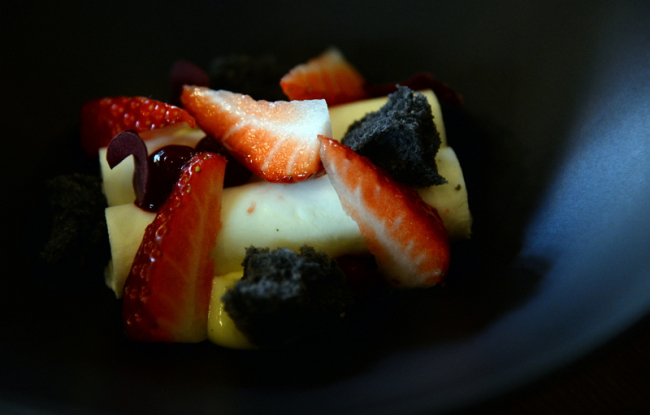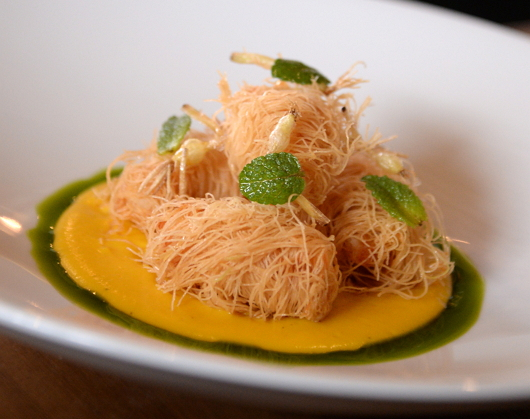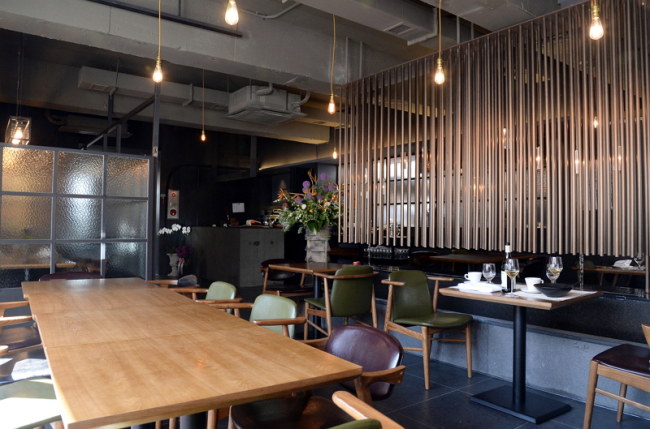A food skeptic might be cautious when they enter the newly minted restaurant of celebrity chef Lee Chanoh.
After seeing a chef on a food television show, they are bound to develop certain expectations. If their expectations are too high, then disappointment inevitably ensues ― but that is not the case at Manu Terrace, veteran chef Lee’s new fusion establishment.
Lee, who is currently appearing on “Olive Show 2015,” spent years honing his talent at restaurants in Australia, France and the Netherlands. At his new restaurant, he does not attempt to outstrip himself with newfangled, over-the-top dishes at gasp-inducing prices.
Instead, he aims to serve reasonably priced food that is seasonally sensitive, fresh-tasting and filling. It is also food that exhibits strong influences from Korean and French cuisine.
 |
Manu Terrace’s picturesque yogurt mousse is dotted with black sesame chiffon cake, strawberries, dehydrated baby red carrots and mint. |
The point, Lee explained, was to make a “fun and friendly space.”
For his restaurant, Lee chose a prime spot on the fourth floor of a building in Seoul’s Cheongdam-dong, complete with a terrace on one side and a dining space on the other.
The outdoor terrace, which at the time was still under construction, would soon transform into a spot where diners could order tapas and tip back craft beer, Lee said as he nibbled on some herbs that were grown in the terrace’s burgeoning garden.
“I really cannot do without nature,” Lee, 31, said on why he chose to open his eatery in a building with a terrace.
 |
In a riff off fish and chips, halibut is wrapped in kadaif noodles and fried, plunked over kabocha squash puree and spinach-infused olive oil and garnished with fresh mint. (Ahn Hoon/The Korea Herald) |
Nature plays a pivotal role, not only in the ambience of Manu Terrace, but in the cuisine as well. This is abundantly clear in dishes like the tasty riff off fish and chips. Flaky white sea bass is wrapped in strands of kadaif noodles, fried and placed on a bed of creamy and vibrantly orange kabocha squash puree. Intense green spinach-infused olive oil pools at the bottom of the dish, which is garnished with mint leaves.
The plating is beautiful, colorful and refreshing to the eye.
“I am most inspired by nature and art,” Lee explained on how he goes about constructing a dish and how he takes texture and color into account.
Taste is clearly also taken into consideration, and the flavors of the kadaif sea bass kabocha squash dish practically pop off the plate.
Kabocha squash puree tastes almost as if the flesh was scooped straight out of the shell and onto the plate, but rendered into a luscious, creamy texture, while the mint is crisp in its freshness, the perfect foil to the crunchy, fried kadaif noodles and near buttery white flesh of the fish.
“It is about using good ingredients,” Lee said.

That same garden fresh vibe is present in dishes like Manu Terrace’s yogurt mousse, which arrives looking like a miniature garden. Crumbly hunks of rich brownie, closely resembling clods of dirt, are scattered over the oblong roll of mousse, which has been liberally decorated with sweet slices of strawberry, dehydrated baby red carrots, mint and caramelized puffed grains.
Those dehydrated carrots are a near revelation, sweet, pungent and delivering a loud punch of flavor.
“We add sugar to the carrots for that last crunch,” Lee explained on how the sweetness of the carrots are amplified with a final touch.
It is this ability to translate fresh ingredients into a visually vibrant and flavor-rich dish that makes Manu Terrace such a pleasant addition to Seoul’s growing repertoire of semi-casual fine dining spots.
Word has already spread. Despite the fact that Manu Terrace was still testing the waters with a quiet soft opening, foodies who had somehow gotten wind of the new spot trailed in and asked about opening hours.
One can only guess what the response will be like following Manu Terrace’s official launch, which took place on April 23.
By Jean Oh (
oh_jean@heraldcorp.com)








![[Herald Interview] 'Trump will use tariffs as first line of defense for American manufacturing'](http://res.heraldm.com/phpwas/restmb_idxmake.php?idx=644&simg=/content/image/2024/11/26/20241126050017_0.jpg)
![[Exclusive] Hyundai Mobis eyes closer ties with BYD](http://res.heraldm.com/phpwas/restmb_idxmake.php?idx=644&simg=/content/image/2024/11/25/20241125050044_0.jpg)
